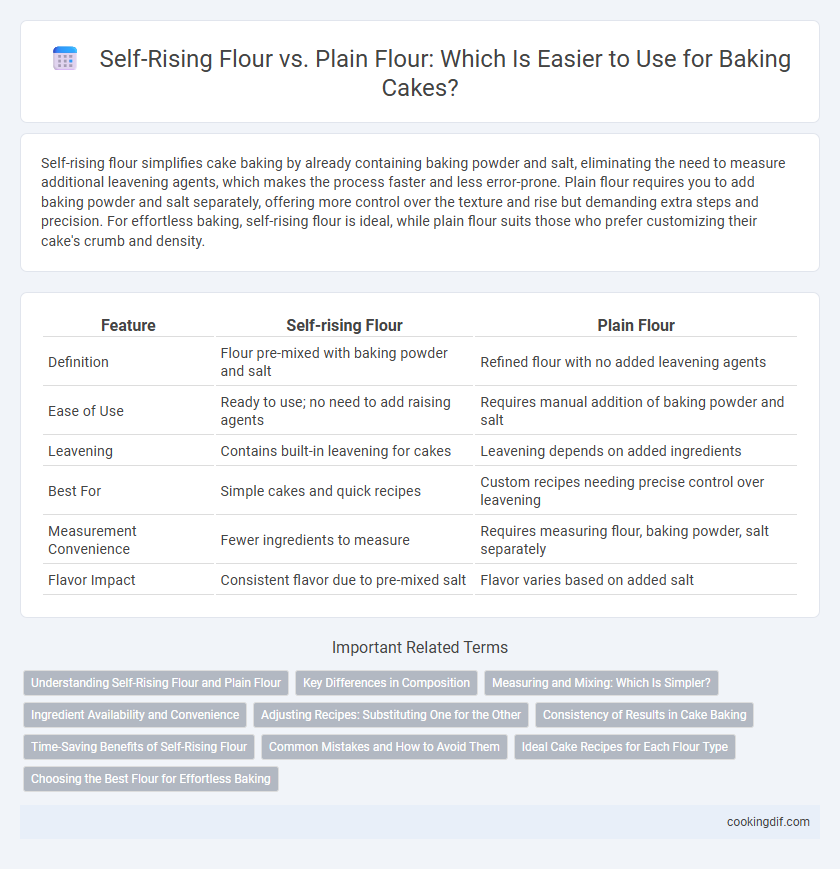Self-rising flour simplifies cake baking by already containing baking powder and salt, eliminating the need to measure additional leavening agents, which makes the process faster and less error-prone. Plain flour requires you to add baking powder and salt separately, offering more control over the texture and rise but demanding extra steps and precision. For effortless baking, self-rising flour is ideal, while plain flour suits those who prefer customizing their cake's crumb and density.
Table of Comparison
| Feature | Self-rising Flour | Plain Flour |
|---|---|---|
| Definition | Flour pre-mixed with baking powder and salt | Refined flour with no added leavening agents |
| Ease of Use | Ready to use; no need to add raising agents | Requires manual addition of baking powder and salt |
| Leavening | Contains built-in leavening for cakes | Leavening depends on added ingredients |
| Best For | Simple cakes and quick recipes | Custom recipes needing precise control over leavening |
| Measurement Convenience | Fewer ingredients to measure | Requires measuring flour, baking powder, salt separately |
| Flavor Impact | Consistent flavor due to pre-mixed salt | Flavor varies based on added salt |
Understanding Self-Rising Flour and Plain Flour
Self-rising flour contains a pre-mixed blend of all-purpose flour, baking powder, and salt, which streamlines baking by eliminating the need to measure leavening agents separately. Plain flour, also known as all-purpose flour, requires additional ingredients like baking powder or baking soda to achieve rising, offering more control but demanding precise measurements. Understanding the composition of self-rising versus plain flour helps bakers select the ideal flour for recipes that prioritize convenience or customization in texture and rise.
Key Differences in Composition
Self-rising flour contains a precise blend of baking powder and salt, making it a convenient choice for quick cakes and baked goods without needing separate leavening agents. Plain flour, also known as all-purpose flour, lacks these additives, requiring additional ingredients like baking powder or baking soda to achieve rise. The key difference in composition affects texture and ease of measurement, with self-rising flour simplifying the baking process by combining dry ingredients in one product.
Measuring and Mixing: Which Is Simpler?
Self-rising flour simplifies measuring and mixing by incorporating baking powder and salt, reducing the need for additional leavening agents. Plain flour requires precise measurement of baking powder and salt, increasing the chance of errors during preparation. Using self-rising flour streamlines the baking process, making it quicker and more foolproof for consistent cake results.
Ingredient Availability and Convenience
Self-rising flour simplifies baking by combining flour, baking powder, and salt, reducing the need for multiple ingredients and precise measurements, which is ideal for quick cake preparation. Plain flour requires separate leavening agents, increasing ingredient availability challenges and adding preparation steps. Convenience in recipes favors self-rising flour for its ready-to-use formula, particularly in regions where baking powder might not be readily accessible.
Adjusting Recipes: Substituting One for the Other
Self-rising flour contains baking powder and salt, simplifying recipes by eliminating the need for additional leavening agents, making it ideal for quick cakes and biscuits. When substituting plain flour, add 1 1/2 teaspoons of baking powder and 1/4 teaspoon of salt per cup to mimic self-rising flour's effect and ensure proper rise and texture. Adjusting recipes carefully maintains the balance of ingredients, preventing dense or overly salty cakes caused by incorrect leavening proportions.
Consistency of Results in Cake Baking
Self-rising flour offers consistent results in cake baking due to its pre-mixed leavening agents, reducing the risk of measurement errors and uneven rise. Plain flour requires precise addition of baking powder or soda to achieve the same leavening effect, which can lead to variability in texture and height. Bakers seeking uniformity and simplicity often prefer self-rising flour to ensure reliable cake structure and crumb.
Time-Saving Benefits of Self-Rising Flour
Self-rising flour contains pre-mixed baking powder and salt, significantly reducing preparation steps and saving valuable baking time. Using self-rising flour eliminates the need for measuring and combining additional leavening agents, streamlining the process for quicker cake batter preparation. This time-saving benefit makes self-rising flour an ideal choice for bakers seeking efficiency without sacrificing texture or rise.
Common Mistakes and How to Avoid Them
Using self-rising flour instead of plain flour without adjusting other ingredients often leads to overly dense or unevenly textured cakes due to excess baking powder and salt. A common mistake is neglecting to omit baking powder and salt when substituting self-rising flour for plain flour, which can be avoided by carefully reading recipes and measuring ingredients accordingly. Ensuring the correct flour type and balancing leavening agents promotes a tender, well-risen cake with consistent crumb structure.
Ideal Cake Recipes for Each Flour Type
Self-rising flour contains baking powder and salt, making it ideal for quick, simple cake recipes like sponge cakes or pancakes that require reliable leavening without extra ingredients. Plain flour, also known as all-purpose flour, offers versatility for more complex cakes such as layered or butter cakes, where precise control over leavening agents and texture is essential. Choosing the right flour ensures optimal rise and crumb structure tailored to the specific cake recipe's requirements.
Choosing the Best Flour for Effortless Baking
Self-rising flour simplifies baking by combining all-purpose flour, baking powder, and salt, making it ideal for quick cakes without measuring multiple ingredients. Plain flour requires adding leavening agents separately, offering more control but requiring precise measurements. For effortless baking, self-rising flour is the best choice to save time and reduce complexity in cake preparation.
Self-rising Flour vs Plain Flour for ease of use Infographic

 cookingdif.com
cookingdif.com